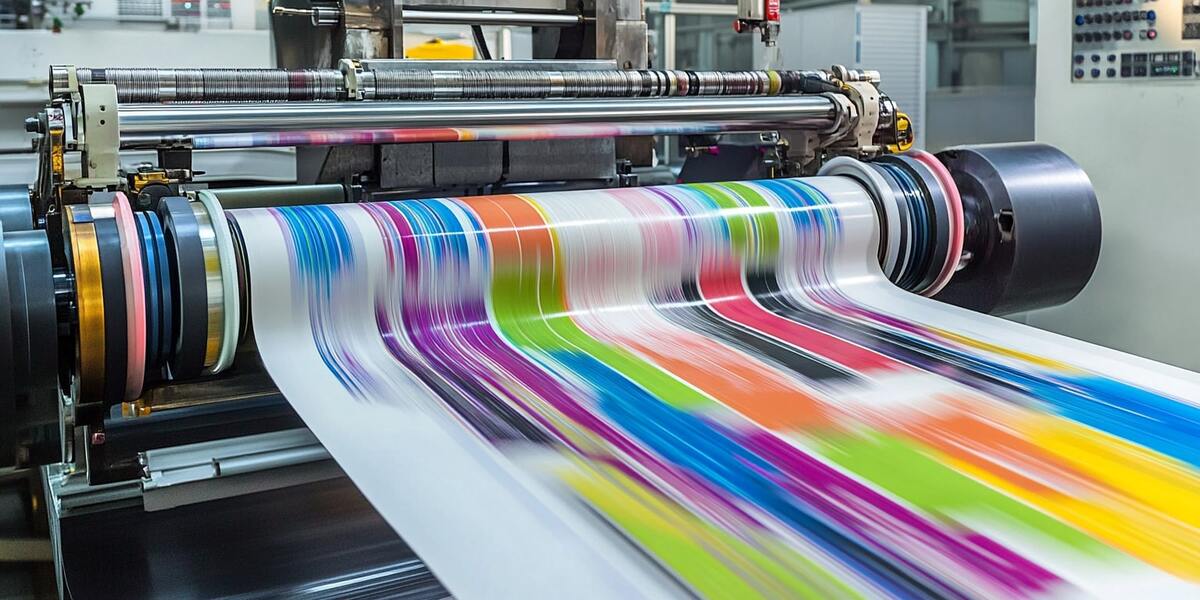
Blog
What is Offset Printing? 5 Cases Where It’s the Ideal Choice

Offset printing is a popular choice for many printing projects due to its efficiency and high-quality results. However, what is offset printing? When should you consider using it? Whether it is the best fit for your next project?
To answer all of these questions, in this blog post, we’ll explore 5 specific cases where offset printing shines as the ideal choice. By determining those specific projects, you can make the right decision for your printing needs.
What is Offset Printing?
Offset printing is a widely used printing technique.
The key components of an offset machine include: plates, blankets and cylinders.
- The plate is made of aluminum and contains the image to be printed. The inked image will be transferred from this plate to a rubber blanket.
- Blanket acts as a flexible intermediary which allows the image to be transferred onto.
- Then the image will be transferred from this blanket onto the printing surface. Here is where the cylinder comes into action as it presses the image onto the final material.
These components ensure that the printed material maintains a high level of detail and consistency throughout the print run.
Types of Offset Printing
Offset printing comes in two main types: sheet-fed and web-fed.
- Sheet-fed: When using this type of printing, we will feed individual sheets of paper into the printing press. It’s ideal for producing high-quality prints in small quantities, such as brochures, posters, and high-end magazines.
- Web-fed: In this method, a continuous roll of paper is fed through the press. It is suitable for high-volume print jobs like newspapers, catalogs, and magazines.
How Offset Printing Works?
When we wonder “What is offset printing?”, we are often curious about its unique process. So let’s learn about this printing process:
- First, a digital image is transferred onto metal plates, typically made of aluminum. These plates are then mounted onto a plate cylinder. Each plate corresponds to a specific color: cyan, magenta, yellow, or black (CMYK).
- Next, the plates are inked with their respective colors. The inked image is transferred from the plate to a rubber blanket on a blanket cylinder. This rubber blanket acts as an intermediary, pressing the image onto the paper or other printing surface.
- Finally, the impression cylinder applies pressure to ensure the ink is evenly and accurately applied to the material. This process is repeated for each color, resulting in a vibrant, multi-colored print.
This process is indirect printing. Although it requires plural steps, it can create high-quality prints with sharp and clean images.
When comparing offset printing and screen printing, another indirect printing method, we can see that they all produce high-quality prints. However, they differ significantly in their methods and applications.
- Screen printing involves pushing ink through a mesh screen onto the printing surface, making it suitable for printing on a variety of materials, including textiles, ceramics, and glass.
- In contrast, offset printing is generally used for paper-based products and offers greater precision and efficiency for large print runs.
Advantages and Limitations
When considering what is offset printing and whether it is the technique you need, it’s essential to weigh its advantages and limitations.
Advantages of Offset Printing
- High printing quality: This printing technique delivers exceptionally high-quality images with sharp details and vibrant colors.
- Cost-effective for large volumes: Offset becomes more cost-effective as the printing volume increases. The per-unit cost decreases significantly with larger print runs, making it an economical choice for bulk printing needs.
Limitations of Offset Printing
- Setup costs: It has higher initial setup costs compared to digital printing. This includes the cost of creating plates and setting up the press, which can make this printing method less economical for small print runs.
- Longer turnaround time: The setup and preparation time required for offset prints is longer than for direct printing methods.
In summary, understanding “what is offset printing” involves recognizing both its strengths and its limitations. It offers high-quality prints and saves cost for large volumes, but for small or urgent print jobs, it may not be a suitable choice.
Products Created using Offset Printing Techniques
Firstly, let’s see what are the materials that can be printed on using this kind of printing.
Compatible materials
Offset printers is compatible with various materials:
- Paper
- Cardstock
- Recycled paper
- Kraft board
- Plastic
- Metallic foil
- Textiles
Main products of Offset printing
Offset printers can work with many materials, so there are various products of offset printing:
- Books
- Magazines
- Newspapers
- Brochures
- Catalogs
- Posters
- Packaging
- Labels (product labels, shipping labels)
- Stickers
- Calendars
- Business cards
- Workbooks
- …
Offset printing can be used for both personal and professional print projects.
5 Cases Where Offset Printing Is the Ideal Choice
Even though this printing allows the production of many other types of printed products, there are cases that it can not be superior to other methods. So if you wondering whether it is the ideal choice for your project, let’s take a look at 5 specific cases where offset printing shines:
1. You print in large runs
Offset printing is perfect for producing large quantities because it will cost you less per item. It also ensures that you get consistent quality across thousands of copies.
If you are in need of printing magazines, newspapers, catalogs,… in high volume, choose offset printing.
2. You need high-resolution images
For projects demanding exceptional image detail, offset prints can be the way to go. It provides superior resolution and vibrant colors on high-quality paper.
So, it’s ideal for printing art books, high-end brochures, annual reports,…
3. Aesthetics labels and packagings
Offset printers works great on printing visually appealing products like packaging and custom labels by producing sharp and vibrant images.
You can use this method to print on boxes, making labels, wrappers, etc.
4. High-quality, branded materials
When it comes to professional and polished materials, offset printing is a good choice.
It provides a high-quality finish for business cards, letterheads, and presentation folders,….
5. Unique or custom projects
Offset printing offers flexibility for unique or custom projects. It can handle various sizes and materials, and offers options for custom finishes and effects.
You can use this printing for large volume custom stickers, custom invitations, limited edition prints…
So, if you find yourself in these specific needs, or with similar purposes, you can choose to use a offset printer.
Wrap it up
After learning about “What is Offset Printing” as well as its benefits, we hope you see whether it’s the go-to method for your prints.
To explore more about printing techniques and how they can benefit your projects, be sure to check out the additional articles on our website. Whether you’re interested in the latest printing technologies or tips for your next print job, there’s plenty more to discover.










